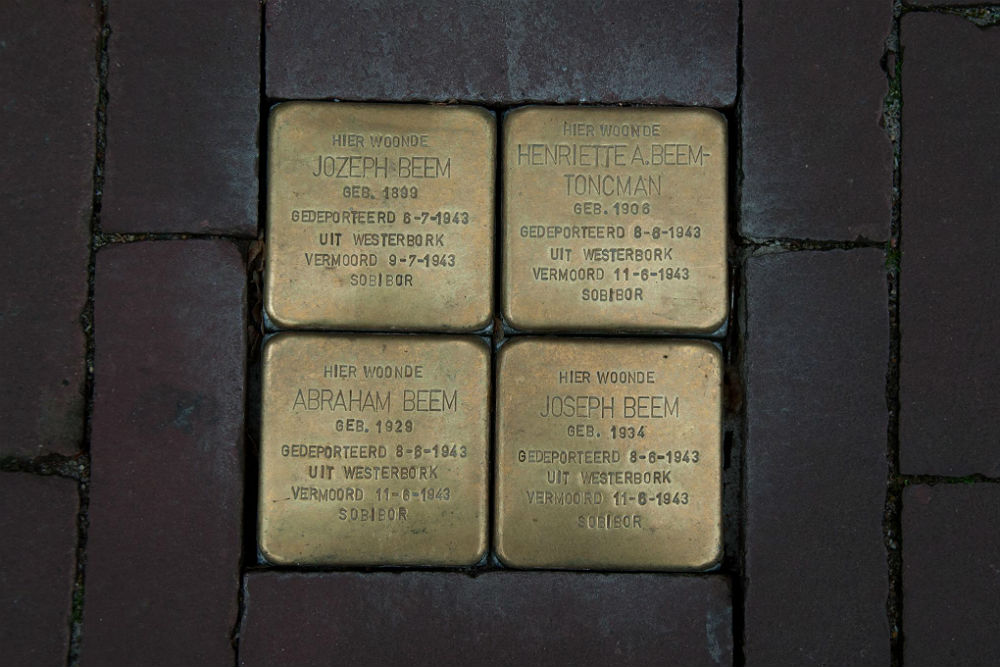Stumbling Stones Kerkstraat 11
Stolpersteine / Stumbling Stones commemorate:
* Jozeph Beem, born 1899, deported 6 July 1943 from Westerbork, murdered 9 July 1943 Sobibor.
* Henriëtte A. Beem-Toncman, born 1906, deported 8 June 1943 from Westerbork, murdered 11 June 1943 Sobibor.
* Abraham Beem, born 1929, deported 8 June 1943 from Westerbork, murdered 11 June 1943 Sobibor.
* Joseph Beem, born 1934, deported 8 June 1943 from Westerbork, murdered 11 June 1943 Sobibor.
In December 1942, the mayor of Oss requested that Jozeph Beem, his wife Henriette and son Abraham be found, arrested and brought to trial because they had changed their residence without the required authorization. This police action was applied to Jews who had gone into hiding.
Henriette Alexandra Beem-Toncman and her two sons were all killed in Sobibor in June, 3 days after being deported from Westerbork. Joseph was 8. Alex was 11. One source (Joods Monument) states that the boys were part of a Vught transport which, the lie was told, would take the children to a special children’s camp. It is not clear whether their mother was with them in Vught. Two transports left Vught for Westerbork and on 08 June, most of the deportees from both were put on another transport of over 3,000 Dutch Jews to the extermination camp in Sobibor.
Jozeph Beem was deported and murdered a month later than his wife and sons.
One of Jozeph’s siblings survived the war. The other, Emanuel Beem, was murdered in Central Europe in 1944, while his wife, daughter and wife’s mother were all murdered in Auschwitz on the same day in 1942.
There are stolpersteine for three of Henriette’s brothers: Henri Toncman (1921-1944) at Kruisstraat 27 in Oss; Alexander Toncman (1908-1942) and his wife at Baljuwplein 66 /Harddraverstraat 78c in Rotterdam; and Abraham Toncman (1905-1943) and his family at Hendrik Westerstraat 247 in Oude Pekela.
"Stolpersteine" is an art project for Europe by Gunter Demnig to commemorate victims of National Socialism (Nazism). Stolpersteine (stumbling stones) are small, 10x10cm brass plaques placed in the pavement in front of the last voluntary residence of (mostly Jewish) victims who were murdered by the Nazis. Each plaque is engraved with the victim’s name, date of birth and place (mostly a concentration camp) and date of death. By doing this, Gunter Demnig gives an individual memorial to each victim. One stone, one name, one person. He cites the Talmud: "A human being is forgotten only when his or her name is forgotten."
Borne was the first town in the Netherlands in which Stolpersteine were placed -- on 29 November 2007.
Do you have more information about this location? Inform us!
Source
- Text: Anne Palmer
- Photos: Peter Mulder
- Joods Monument
- Geni.com
- Yad Vashem Transports to Extinction: Vught-Westerbork
- Stolpersteine.eu
Nearby
Point of interest
Monument
- Monument Titus Brandsma Oss - Oss
- War Memorial Town Hall Oss - Oss
- Memorial Killed NS Employee - Oss
Cemetery
- Dutch War Grave Roman Catholic Cemetery Berghem - Berghem
- Commonwealth War Graves Roman Catholic Cemetery Heesch - Heesch
- Dutch War Grave Roman Catholic Cemetery Heesch - Heesch
Remembrance Stone
- Stumbling Stones Monsterstraat 6 - Oss
- Stumbling Stones Koornstraat 3 - Oss
- Stumbling Stones Koornstraat 1 - Oss





